Voices of Biotech
Podcast: MilliporeSigma says education vital to creating unbreakable chain for sustainability
MilliporeSigma discusses the importance of people, education, and the benefits of embracing discomfort to bolster sustainability efforts.
Many potentially therapeutic products involve the culture of stem cells. Their commercial success depends on the development of scalable good manufacturing practice (GMP) technologies that can both robustly and cost-effectively produce very large numbers of cells. Through many improvements and innovations in bioprocessing operations over the years, fed-batch suspension culture has remained the most common mode for large-scale biopharmaceutical manufacturing. However, some recent events suggest that may be changing (1,2). For the culture and expansion of stem cells, large-format adherent flask culture has gained significant favor. Here we investigate the potential of a new large-scale three-dimensional (3-D) cell mass expansion technology for meeting such commercial applications. It emphasizes continuous processing rather than batch production, with the mimicking of natural in vivo conditions as closely as possible.
Stem cells are distinguished from other cell types by two important characteristics. First, they are unspecialized cells capable of renewing themselves through division (sometimes after long periods of inactivity). Second, under certain physiologic or experimental conditions, they can be induced to become tissue- or organ-specific cells with particular functions. Many individual therapies for which stem cells might be applicable are in development. However, there are as yet few approved stem cell therapies that use “expanded” primary cell populations.
Multiple systems for therapeutic stem-cell expansion are being championed by different companies through early stage clinical trials (3). Large-format, adherent, flask culture may not provide the most physiologic or desirable culture conditions for stem-cell expansion. Any therapeutic regenerative medicine system for such expansion would ideally have the following characteristics: CGMP compliance; a simple, sterile, closed fluid path; automation; freedom from serum and animal products; and conditions that maintain specific, desired cell phenotypes. Single-use, continuous processing systems meet those criteria for expansion of stem cells in regenerative medicine.
Continuous Processing
The concept of continuous processing (CP) is certainly not new; in fact, it is the mainstay of many modern industries such as steel and paper production. Until recently, however, applications in pharmaceutical production have been severely limited in both the operations addressed and the instances of successful use. As the name suggests, CP operates continuously, with raw materials constantly flowing in and out of manufacturing equipment and continually processed into intermediate or final products. This is by contrast with episodic “batch” production, in which a specific quantity of drug is made in a single, discrete volume through one manufacturing cycle.
The advantages of CP are numerous (4). Manufacturing is conducted more efficiently using more automation and less human intervention. CP is well supported by regulatory agencies. Janet Woodcock — director of the US Food and Drug Administration’s (FDA’s) Center for Drug Evaluation and Research (CDER) — has even predicted the obsolescence of batch processing in favor of CP for pharmaceutical manufacturing (5). It is one of the stated goals of quality by design (QbD) and is therefore supported by the FDA’s initiatives toward flexible regulatory approaches and science-based quality and control specifications. Current FDA and European Medicines Agency (EMA) regulations and guidance are generally neutral (saying nothing) on manufacturing modes and very accommodating in approaches to lot definition and validation (6).
Single-Use in Bioprocessing
In bioprocessing, single-use (SU) refers to equipment and materials that are used for one processing batch or campaign, usually involving product-contact surface elements that are disposable. Such equipment ranges from single-material, very simple, stand-alone items such as lengths of tubing to complex and controlled systems comprising many components and materials, such as bioreactors (7,8). Over the past 10 years or so, the number of SU process activities, upstream operations supports, and systems available has grown substantially while reducing contamination risks; lowering initial investment, facility, and operating costs; reducing operator requirements; increasing process efficiency and flexibility, and speeding time to market through ease of use. Because of the numerous features they provide, SU systems have been taken up in many areas of biopharmaceutical manufacturing:
Cell culture for seed expansion and production
Media, buffer, and process liquid preparation
Liquid pumping, filtration, collection, and shipping
On-line contents monitoring with sensors and samplers
Transport and storage of process intermediates and end-products
Cryopreservation of seeds and intermediates.
Hollow-Fiber Perfusion Bioreactor
The Hollow Fiber Perfusion Bioreactor (HFPB, Photo 1) system from FiberCell Systems is a high-density, single-use, continuous perfusion culture system (9,10,11). Thousands of semipermeable hollow fibers are arrayed in parallel within a tubular housing (cartridge) and arranged so that any liquid entering the ends of that cartridge flows through the interior of those fibers. Cells are generally seeded within the cartridge housing but outside the hollow fibers in what is referred to as the extracapillary space (ECS). Culture medium is pumped through the hollow fibers to allow nutrients, waste products, and gas to diffuse across the fiber walls in either direction. Once having been through such exchange, media can be either oxygenated and cycled back to the cartridge or harvested to allows fresh medium to be introduced to the system. Specific matrices, cytokines, or antibodies can be bound to the surface of the hollow fibers. Because they present a completely SU flow path, they can be combined with SU bioprocess containers (BPC) up- and downstream to operate for extended periods of time as a closed system.
Photo 1:
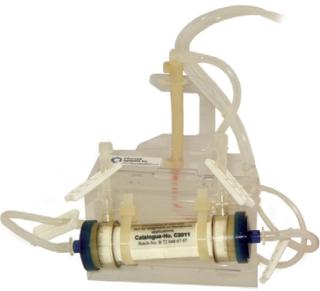
Three fundamental features of an HFPR system are its extremely high fiber surface-to-volume ratio, the porous fiber surface matrix supporting indefinite immobilized culture, and the selectable properties of the fibers for retention of growth factors or concentration of secreted product. Hollow-fiber bioreactors present a fundamentally different way to grow and expand cells. Cultured on a porous fiber support, cells require no splitting and can be maintained for months to a year or more. They continue to grow postconfluence at high density, in three dimensions, and in multiple layers.
High-density 3-D cultures of cells in hollow-fiber bioreactors demonstrate greater amenability to serum- and protein-free media than do those in lower-density systems. Culture conditions such as oxygen tension and me
dia composition can be controlled closely. In a hollow-fiber bioreactor system, it is easy to separate suspension from adherent cells simply by flushing the extracapillary space. Overall this increasingly natural (biomimetic) approach more closely resembles the original in vivo growth conditions of stem cells than classical suspension or adherent systems can.
Requirements for Therapeutic Applications of Stem Cells
The emerging application of human stem cells for medical therapies is advancing in great strides, with many potential sources and applications covering many disease states. Traditional reductionist biological investigation is founded on the isolation and separation of components (animals, organs, and cells) into functional subunits to study their individual roles and functions. But for stem cells, it can be instructive to take a step back and understand their normal operation within in-vivo–like systems that include cell–cell interactions and specific cytokine controls.
By their very definition, stem cells are continually produced in vivo. A challenge for their continuous production — beyond culture and expansion — is harvesting them. Some practitioners have observed the possibility that particular actively dividing stem cells detach during division and then reattach to their support matrix. Collecting cells from cocultures will inevitably select for suspension cells — thus potentially, those that are more actively dividing. Two types of stem cells produced continuously might readily lend themselves to continuous harvesting and production in vitro (as they are in vivo): mesenchymal stem cells (MSCs) derived from placenta coculture and hematopoietic stem cells (HSCs) derived from bone marrow coculture.
Placental MSCs
Many different types and sources of stem cells are available for research interests and potential therapeutic applications. MSCs can proliferate in vitro and differentiate into mesoderm-type lineages: e.g., osteoblasts, chondrocytes, adipocytes, myocytes, and vascular cells. As a result, MSCs provide a versatile source of progenitor cells for research and clinical applications in tissue regeneration.
One source of human MSCs (hMSCs) is gaining interest: the human placenta, umbilical cord, and amnion. Sourcing from postpartum placentas offers a variety of advantages, primarily easy acquisition and a relative lack of ethical problems. Placental cells are also “immunologically naïve,” which greatly reduces the incidence of graft versus host disease (GVHD) in therapeutic applications.
Some evidence supports the notion that culture conditions can affect the pluripotency and plasticity of stem cells. Their ability to differentiate into different cell types appears to diminish with passage number and exposure to states of high confluency. That constitutes a disadvantage for using flasks and monolayer cultures for expansion. Some data indicate that 3-D cultures may facilitate the retention of specific surface markers associated with MSC function, such as cell-adhesion regulator CXCR4. Nontraditional cell culture methods that provide different cell culture conditions might play an important role in adherent-cell populations of such distinct phenotypes as those presenting stromal elements or secreting cytokines.
Placental mesenchymal stem cells (PMSCs) are commonly expanded for use in two-dimensional (2-D), monolayer cultures. However, large-scale production for clinical applications has recently shifted the industry’s preference toward 3-D suspension culture systems, such as on microcarriers (MCs) in conventional cell bioreactors. The HFPB represents another approach to 3-D culture. We examined its ability to more closely reflect the microenvironment of a human placenta.
Preparation of PMSCs: Full-term human placentas were sourced from the National Disease Research Interchange (NDRI) with approved protocols and consent documentation. They were initially allowed to drain in a strainer, with the drained fluid retained as an initial blood fraction. Then each placenta was intubated and perfused with PBS for an hour using a FiberCell Systems Duet pump. Nonadherent stem cells and other nucleated cells were collected from the resulting perfusate. Then the placenta was perfused with cell culture medium containing collagenase for an hour in a 37 °C humidified cell culture incubator. Digested tissue was manually disaggregated and strained through cheese cloth. Then before resuspension in 20 mL of fresh medium, the collected cells were washed once in cell culture medium — Dulbecco’s modified Eagle’s medium, nutrient mixture F12 (DMEM/F12) from Thermo Fisher Scientific with 10% fetal bovine serum (FBS) and 2% penicillin streptomycin from Life Technologies.
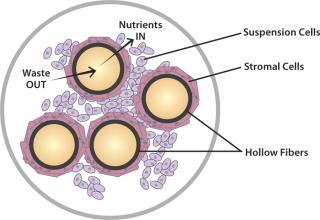
We retained some cells for analysis and seeded the remainder into FiberCell C2008 5-kD molecular weight cut-off (MWCO) polysulfone cartridges. Each cartridge has 3,000 cm2 of surface area in a volume of 20 mL. The cartridge and single-use flow path were placed onto a Duet pump and a culture initiated with 100 mL of cell culture medium at a flow rate of 60 mL/min. At intervals of two to seven days, ECS media were collected by syringe aspiration to harvest nonadherent cells, which were then cultured in T flasks at standard conditions.
HFPB Single-Use Continuous Processing of PMSCs: The mixed cell population thus derived from whole placenta represents a coculture that should mimic the structure and function of an intact placenta. It is generally speculated that placentas are a rich source of various types of stem cells with the advantage of being only nine months old (compared with the age of adult-derived stem cells). Together the 3-D matrix and the concentration of autocrines afforded by the 5-kD MWCO fiber (possibly providing a required cytokine “cocktail”) could support the de novo generation of a stem cell types similar to how they are normally produced in vivo.
Harvests from the ECS performed every three to four days over a three-month period showed very few normal-sized nuclear cells. But when that harvest was placed into a flask, a confluent cell layer observed within four days indicated rapid growth. We also saw numerous spheroids on the surface of the culture (Photos 2). The adherent cells in the flask stained strongly for MSC markers, whereas the flow pattern of the initial harvest was much less defined. That indicates a change in phenotype of the flask-cultured cells from that of the initial suspension ECS harvest. Based on these observations, we believe that this placental coculture may be continuously producing very small, embryonic-like stem cells in significant numbers.
Photos 2:

Results
We made no attempt to isolate a specific, homogenous population of cells, rather loading the cartridges with known mixed-cell populations from placental digests (Photo 3). Although the distribution of phenotypes elutriated from the placenta varied from cycle to cycle, Table 1 summarizes typical collected phenotypes. Cells produced in this system grew rapidly and showed morphologies consistent with mesenchymal stem cells, produced embryoid bodies, and demonstrated MSC characteristics determined by flow analysis.
Photo 3:
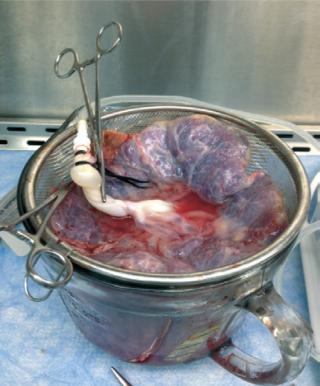
Table 1:
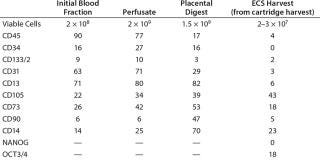
One cartridge continually produced viable “static” cultures from the ECS for over three months. In general, as ECS harvests progressed over time, the amount of cell debris (presumed to be from nonviable cells and/or residual placental tissue) dropped. Significant cell numbers (on average, 1 × 106) were extracted from the cartridge every two to seven days. Aggregates of cells resembling embryoid bodies were harvested from the cartridge throughout the continuous three months of culture (Table 2).
Table 2:
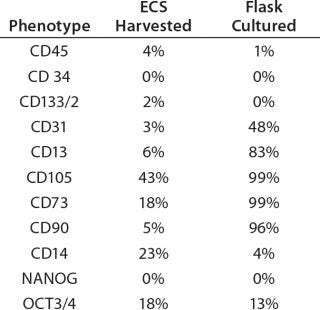
Taken together, our data and observations indicate that that the primary phenotypes in placenta blood and perfusion fractions are hematopoietic stem cells (CD45, CD133, and CD34) with both myeloid precursor (CD14 and CD45) and endothelial progenitors (CD14 and CD31). When we examined cells recovered from the ECS and plated on flat-bottomed polystyrene cultures, the hematopoietic component is much reduced whereas the mesenchymal (CD73, CD90, and CD105) and periocyte component (CD13 and CD31) increases.
Hematopoietic Stem Cell Culture
HSCs are produced continually in bone marrow, a complex environment made up of several cell types. Harvesting this microenvironment is not as straightforward as it is for placenta. However, bone marrow stromal cell lines have been developed. Certain HSCs have the advantage of being nonadherent, which facilitates harvesting.
Mayasari Lim and her colleagues at Singapore’s Nanyang Technological University have used a hollow-fiber bioreactor as a model system for bone marrow coculture (12). They developed a hematopoietic coculture model consisting of an adherent HS-5 bone marrow stromal cell line and cocultured it with erythroleukemia K562 cells. That generated a continuous culture that expanded the K562 cells over a period of several weeks with multiple harvests. The coculture resulted in much greater leukemic expansion — 3,100-fold — than the 43-fold expansion that occurred when the cells were cultured in tissue culture plates. Differentiation tendencies in tissue-culture plates favored maturation toward monocyte and erythrocyte lineages while maintaining a pool of myeloid progenitors.
The hollow-fiber coculture model demonstrated greater lineage diversity, stimulating monocytic and megakaryocyte differentiations while inhibiting erythroid maturation. Extensive stromal expansion capacity is potentiated by the large amount of available surface area and the porous support for stromal cells, which precludes the requirement for cell splitting. Enhanced activity was noted with the 5-kD MWCO fiber over that with the 20-kD MWCO fiber, demonstrating that cell–cell contact and cytokine concentration could be important factors in this bone marrow model. The in vitro system represents a dynamic and scalable 3-D coculture platform mimicking the bone marrow microenvironment.
A Viable Option
We have described a highly reproducible, straightforward methodology for expansion of multipotent MSCs from human term placentas and a potential model for coculture of human bone marrow. HFPR systems offer a unique environment for single-use, continuous, ex vivo expansion and proliferation of stem cells over time. HFPR-cultured cells are bound to a porous support as they are in vivo and maintain postconfluent viability and production-relevant metabolism for extended periods without episodic subculturing. The more in-vivo–like continuous growth conditions afforded by HFPR systems significantly reduces apoptosis.
The extremely high ratio of surface area to volume (~100–200 cm2/mL) coupled with the high gross filtration rate of metabolites supported cell densities of 1–2 × 108/mL — close to in-vivo–like tissue densities. A significant increase in glucose uptake rate occurs with the 5-kD MWCO cartridge than with the 20-kD MWCO cartridge (data not shown). That is probably due to retention of cytokines within the ECS. The porous hollow fiber supports permit continuous culture of primary human cells to be maintained for up to three months.
During that period, a significant number of cells presenting stem-cell markers and what appeared to be embryoid bodies were generated within the cartridge. When plated, a certain portion of the population would attach and display relevant morphology while the embryoid bodies themselves seemed to remain intact. Attaching cells appeared to be associated with clusters as in Figure 2. These data show that the HFPR system can support continuous culture of primary human placental-derived cells for a number of applications over extended periods. Continuous production of conditioned medium another feature of the HFPR system. Further work will characterize cells generated by this system and optimize culture conditions.
The upstream media preparation and downstream media containment system used here consisted of SU mixers, filtration, manifold distribution
, and bioprocess containers from Thermo Fisher Scientific (Photo 5). That assembly was conjoined to a FiberCell Systems HFPB reactor, resulting an entirely SU processing flow path. This novel assembly reduces contamination risks, lowers initial investment costs, and provides efficiency and flexibility of process design. Our experiments demonstrate its capability to support continuous production of certain stem cell types in a single-use system. HFPB systems offer a unique environment for culturing primary cells and mixed cell populations that recapitulate the in vivo environment. Larger-scale systems could produce stem cells continuously to meet the criteria for biomanufacturing them on a clinical scale.
Photo 4:
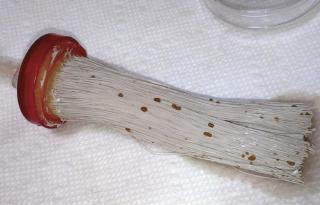
Photo 5:

About the Author
Author Details
Corresponding author William G. Whitford Sr. is bioprocessing market manager at Thermo Fisher Scientific, 925 West 1800 South, Logan, UT 84321; 1-435- 792-8277; [email protected]. James C. Hardy is president and chief scientific officer of Hemacell Perfusion Inc. in Silver Spring, MD. And John J.S. Cadwell is president and CEO of FiberCell Systems Inc. in Frederick, MD.
1.) Weintraub, K 2013.Biotech Firms in Race for Manufacturing Breakthrough MIT Technol. Rev.
2.) Pollock, J, SV Ho, and SS Farid. 2013. Fed-Batch and Perfusion Culture Processes: Economic, Environmental, and Operational Feasibility Under Uncertainty. Biotechnol. Bioeng. 110:206-219.
3.) Olmer, R 2013. Scalable Expansion of Human Pluripotent Stem Cells in Eppendorf BioBLU® 0.3 Single-Use Bioreactors, Eppendorf, Hamburg.
4.) Whitford, WG 2013. Supporting Continuous Processing with Advanced Single-Use Technologies. BioProcess Int. 11:46-52.
5.) Woodcock, J 2011.FDA: The Next 25 YearsAAPS Annual Meeting and Exposition, Washington.
6.) Whitford, WG 2012. Single-Use Systems Support Continuous Processing in Bioproduction. PharmaBioWorld 10.
7.) Whitford, WG 2010. Single Use Systems as Principal Components in Bioproduction. BioProcess Int. 8:34-42.
8.) Whitford, B 2010. Single Use Systems Support of PAT and QbD in Bioproduction. Life Science Leader 2:36-38.
9.) Whitford, WG, and JJS Cadwell. 2009. Interest in Hollow-Fiber Perfusion Bioreactors Is Growing. BioProcess Int. 7:54-63.
10.) Cadwell, JJS 2013.Novel Large-Scale Bioreactor Supports Continuous Manufacturing. Pharmaceutical Biotechnology: Protein Engineering SessionSecond Biotechnology World Congress, Dubai.
11.) Langer, ES 2011. Trends in Perfusion Bioreactors: Will Perfusion Be the Next Revolution in Bioprocessing?. BioProcess Int. 9:18-22.
12.) Usuludin, S. 2012. Co-culture of Stromal and Erythroleukemia Cells in a Perfused Hollow Fiber Bioreactor System as an in vitro Bone Marrow Model for Myeloid Leukemia. Biotechnol. Bioeng. 109:1248-1259.
You May Also Like